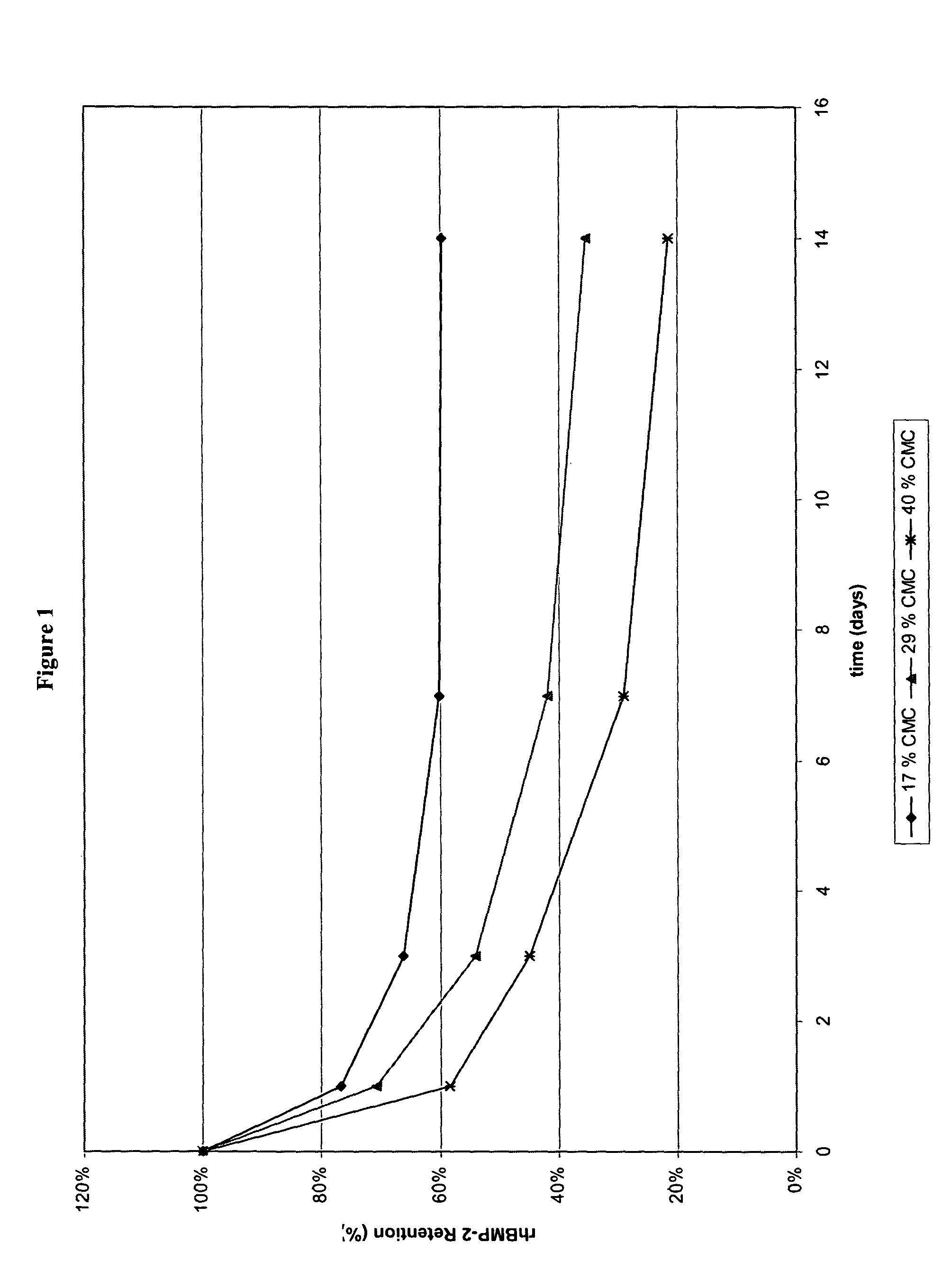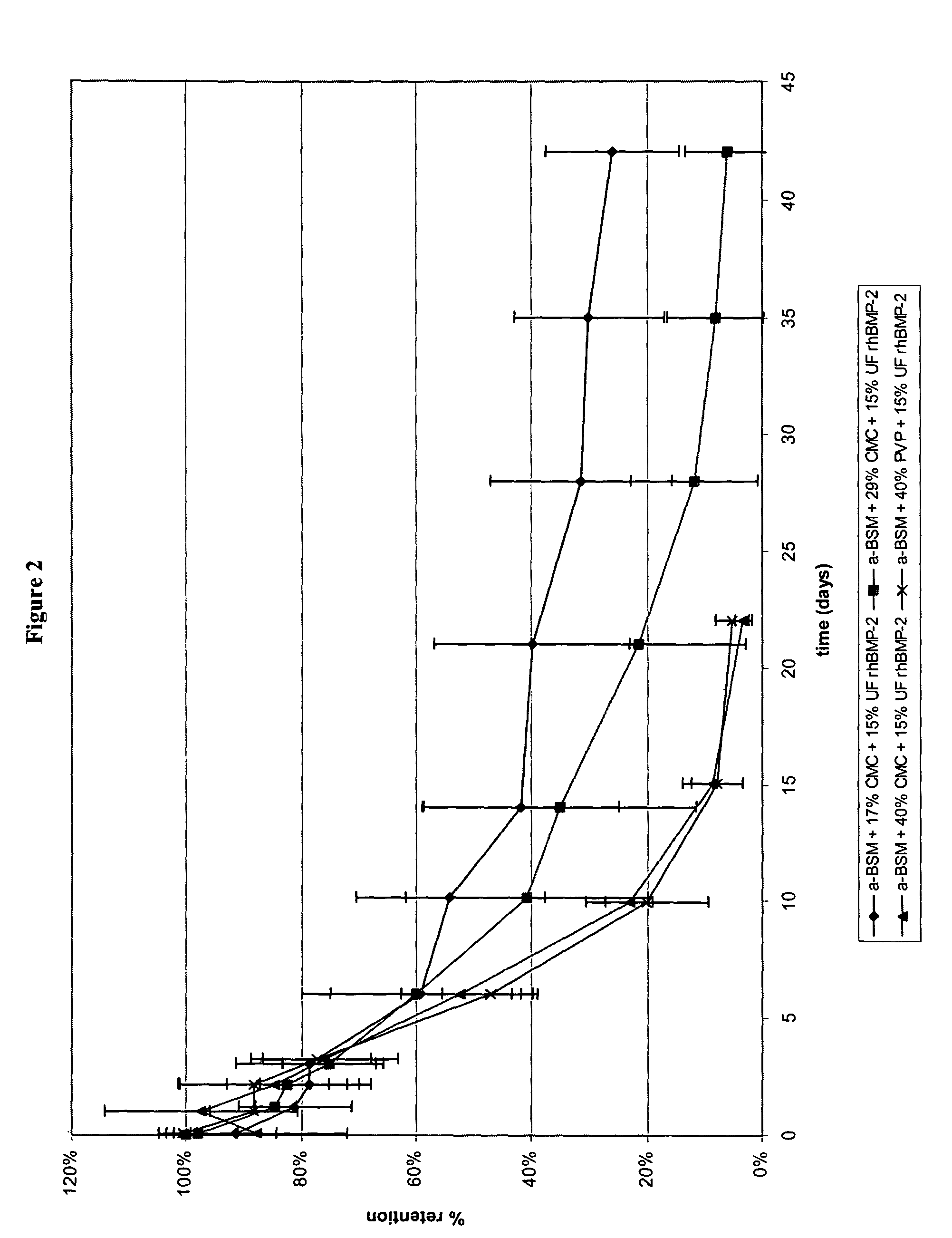Injectable calcium phosphate solid rods and pastes for delivery of osteogenic proteins
a technology of calcium phosphate and solid rods, which is applied in the field of osteoporosis proteins and pharmaceutical formulations, can solve the problems of osteoporosis being associated with a substantial morbidity and mortality, and difficult to treat osteoporosis
- Summary
- Abstract
- Description
- Claims
- Application Information
AI Technical Summary
Benefits of technology
Problems solved by technology
Method used
Image
Examples
example 1
Formulation
[0067][66] Various injectable solid rods (A-E) of α-BSM, rhBMP-2, and one of carboxymethylcellulose (CMC), polyvinylpyrrolidone (PVP) and dextran sulfate were prepared. Dry powders of each component were combined in a sterile mixing bulb and reconstituted into a stiff putty by the addition of a a glycine-based aqueous buffer having a pH of about 4.5 and comprising 5 mmol L-glutamic acid, 2.5% glycine, 0.5% sucrose, 5 mmol NaCl and 0.01% polysorbate 80 at a specified liquid (ml) to powder (g) ratio (L / P) and kneaded for 1 minute to form a paste. The amounts of each ingredient, as well as the particular L / P ratios employed, were as set forth in Table 1 below.
[0068]
TABLE 1α-BSMrod(wt %)rhBMP-2 (wt %)L / P ratioCMC (wt %)A6817151.0B5629151.2C4540151.5PVP (wt %)D4540150.6dextran sulfate(wt %)E4540150.6
[0069]Each paste was loaded into a syringe and extruded to form cylindrical rods having a diameter of about 1 mm and a length of about 5 cm. These 5 cm rods were then cut to desire...
example 2
In vitro Characterization
[0072]A correlation was observed between additive content and particle formation. Upon submersion in the glycine-based aqueous buffer described in Example 1 for 14 days, rods containing higher % additive (40% CMC, 40% PVP, or 40% dextran sulfate, i.e., rods C-E, respectively) dispersed into smaller particles faster, i.e., within 1 day, than those with medium (29% CMC, i.e., rod B) and low (17% CMC, i.e., rod A) additive contents. Rods containing low additive contents (17% CMC, i.e., rod A) maintained their rod-like structure much longer, i.e., on the order of days to weeks, than their higher CMC counterparts.
[0073]In addition, in vitro release kinetics of rhBMP-2 from α-BSM rods containing either 17% (rod A), 29% (rod B), or 40% (rod C) CMC was performed using 125I-rhBMP-2 as a tracer. Similar to gross observations, rods containing higher % CMC released rhBMP-2 faster than those with lower % CMC as shown in FIG. 1.
example 3
Rat Biocompatibility and Efficacy Study
[0074]Injectable rod-shaped calcium phosphate-based compositions (prepared as described in Example 1) were evaluated for biocompatibility and efficacy, both intraosseous and ectopic, in a rat model.
[0075]Intraosseous core defects were surgically established in the distal femurs of six male CD rats. The rats were divided into two groups (A and B) of three. One limb from each rat received a 2 mm segment test rod (calcium phosphate / rhBMP-2 / excipient), while the contralateral limb received a 2 mm segment control rod (calcium phosphate / excipient). The rats of Group A received rod A (68 / 17 / 15 (w / w) % ACP / CMC / rhBMP-2) of Example 1 as the test rod, while the rats of Group B received rod B (56 / 29 / 15 (w / w) % ACP / CMC / rhBMP-2) of Example 1 as the test rod. In addition, one 10 mm rod was implanted subcutaneously lateral to the midline of the ventral thorax region, with one side receiving a test rod and the other side receiving a control rod. Here again, the...
PUM
| Property | Measurement | Unit |
|---|---|---|
| length | aaaaa | aaaaa |
| length | aaaaa | aaaaa |
| length | aaaaa | aaaaa |
Abstract
Description
Claims
Application Information
 Login to View More
Login to View More - R&D
- Intellectual Property
- Life Sciences
- Materials
- Tech Scout
- Unparalleled Data Quality
- Higher Quality Content
- 60% Fewer Hallucinations
Browse by: Latest US Patents, China's latest patents, Technical Efficacy Thesaurus, Application Domain, Technology Topic, Popular Technical Reports.
© 2025 PatSnap. All rights reserved.Legal|Privacy policy|Modern Slavery Act Transparency Statement|Sitemap|About US| Contact US: help@patsnap.com


